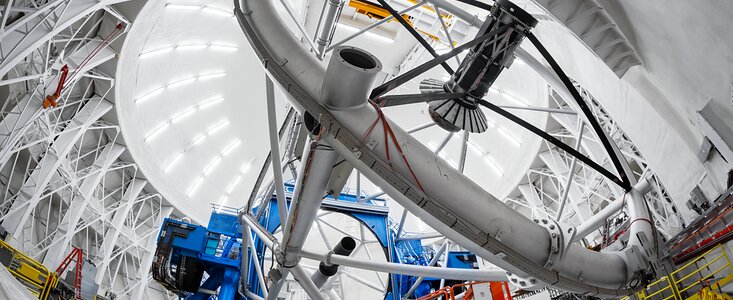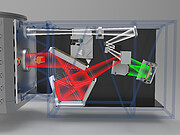International Gemini Observatory Teams Up With Consortium on Gemini North Adaptive Optics Project
Australia-France Consortium led by Macquarie University's Australian Astronomical Optics selected to build Gemini North’s Adaptive Optics Bench
5 December 2023
The International Gemini Observatory, a Program of NSF’s NOIRLab, and AURA are pleased to announce that Macquarie University's Australian Astronomical Optics (AAO) team has been selected, on behalf of the National Science Foundation, to continue the development, construction and installation of the Gemini North telescope’s Adaptive Optics Bench (AOB) [1]. The AOB serves as a sub-component of the larger Gemini North Adaptive Optics (GNAO) facility that will make Gemini North the premier site for high-resolution astronomy for the Gemini International partnership, including the US community.
The GNAO project recently completed a one-year competitive design phase for the AOB sub-component. Three teams developed independent conceptual designs for the AOB and each proposed a path toward the final design, build and installation at the telescope. Of the three teams, Macquarie University's AAO team was selected.
The AOB project is an Australian-French consortium led by Macquarie University's AAO team, in collaboration with the Advanced Instrumentation and Technology Centre (AITC) of the Australian National University, the French Aerospace Laboratory (Office national d'études et de recherches aérospatiales, or ONERA), Marseille Astrophysics Laboratory (Laboratoire d’Astrophysique de Marseille, or LAM), the Observatoire de Haute Provence (OHP) and French specialist optical manufacturer ALPAO. The partnership also includes consulting firms Space ODT (Portugal), Mersenne Optical Consulting (New Zealand), and Wakea Consulting (France).
The Gemini North telescope supports research across many areas of modern astronomy including the Solar System, exoplanets, star formation, galaxy evolution, supermassive black holes, and the large-scale structure of the Universe. As a ground-based facility, the telescope utilizes adaptive optics technology to compensate for the blurring effects of Earth’s atmosphere.
The GNAO facility will correct the incoming light using four main sub-components: a real-time control system, a facility system controller, a laser guide star facility projecting four artificial guide stars in the sky, and the AOB. The facility will enable the instruments to ‘see’ sharper and fainter images of the objects under study, thereby increasing the scientific potential of the images.
GNAO will operate in the nightly queue and will work in tandem with the upcoming Gemini Infrared Multi-Object Spectrograph (GIRMOS) to achieve precise and high-performance spectroscopy and imaging science. “Together, GNAO and GIRMOS will bring the Gemini community into a new exciting era of high resolution astronomical science in the Northern Hemisphere,” said Gaetano Sivo, GNAO’s Principal Investigator.
“The Australian-French consortium has developed a viable, performant and attractive conceptual design,” said Célia Blain, GNAO Project Work Package Manager. “Their combined deep expertise in ground-based adaptive optics systems and collaborative attitude have placed them in the leading position.”
Gemini Observatory is looking forward to collaborating with Macquarie University's AOB team over the next five years to bring the AOB system and the GNAO facility to life. First light of the GNAO facility is anticipated for mid-2028.
Notes
[1] The GNAO AOB is funded by the National Science Foundation under AST Nos. 1546092 and 1839225.
More information
NSF’s NOIRLab (National Optical-Infrared Astronomy Research Laboratory), the US center for ground-based optical-infrared astronomy, operates the International Gemini Observatory (a facility of NSF, NRC–Canada, ANID–Chile, MCTIC–Brazil, MINCyT–Argentina, and KASI–Republic of Korea), Kitt Peak National Observatory (KPNO), Cerro Tololo Inter-American Observatory (CTIO), the Community Science and Data Center (CSDC), and Vera C. Rubin Observatory (operated in cooperation with the Department of Energy’s SLAC National Accelerator Laboratory). It is managed by the Association of Universities for Research in Astronomy (AURA) under a cooperative agreement with NSF and is headquartered in Tucson, Arizona. The astronomical community is honored to have the opportunity to conduct astronomical research on Iolkam Du’ag (Kitt Peak) in Arizona, on Maunakea in Hawai‘i, and on Cerro Tololo and Cerro Pachón in Chile. We recognize and acknowledge the very significant cultural role and reverence that these sites have to the Tohono O’odham Nation, to the Native Hawaiian community, and to the local communities in Chile, respectively.
Links
Contacts
Gaetano Sivo
GNAO Principal Investigator
Email: gaetano.sivo@noirlab.edu
Célia Blain
GNAO Project Work Package Manager
Email: celia.blain@noirlab.edu
Stephen Goodsell
GNAO Project Director
Email: stephen.goodsell@noirlab.edu
Josie Fenske
Jr. Public Information Officer
NSF’s NOIRLab
Email: josie.fenske@noirlab.edu



